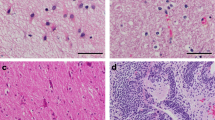Summary
Teratocarcinomas were obtained by transplantation of 7 day old mouse egg-cylinders under the kidney capsule of adult isogeneic animals in order to visualize the histogenesis in the teratocarcinomas. The sequence of histochemical changes roughly corresponds to the events taking place in the developing organism. The origin of differentiated tissues could not be traced histochemically because of the changes which occur in the enzyme pattern during differentiation. No “marker” enzymes were found to enable us to link the differentiated tissues with the undifferentiated embryonal carcinoma cells. The latter cells displayed a low activity of oxydative enzymes and virtually no activity of acid hydrolases, but were rich in alkaline phosphatase. Histochemically they are similar to ecto-mesodermal cells of the egg-cylinder from which the teratocarcinomas were derived. In conjunction with previous ultrastructural findings these data indicate that embryonal carcinoma cells are cells which did not differentiate, but proliferate, retaining morphologic and probably some functional characteristics of undifferentiated ecto-mesodermal cells from the early postimplantation stages of development.
Zusammenfassung
Teratocarcinome wurden durch Transplantation von Eicylindern 7 Tage alter Mäuse unter die Nierenkapsel von erwachsenen isogenen Tieren erzeugt, um die Histogenese in den Teratocarcinomen zu verfolgen. Der Ablauf der histochemischen Veränderungen entspricht etwa dem des sich entwickelnden Organismus. Die Herkunft der differenzierten Gewebe konnte wegen der während der Differenzierung sich abspielenden Veränderung des Enzymmusters histochemisch nicht verfolgt werden. „Marker“-Enzyme, die es erlauben würden, die differenzierten Gewebe mit undifferenziertem embryonalen Gewebe in Verbindung zu bringen, konnten nicht gefunden werden. Die embryonalen Zellen zeigten eine geringe Aktivität der oxydativen Enzyme und praktisch keine Aktivität saurer Hydrolasen, waren aber reich an alkalischer Phosphatase. Histochemisch sind sie ähnlich den ecto-mesodermalen Zellen des Eicylinders, von dem das Teratocarcinom abstammte. Zusammen mit früheren elektronenmikroskopischen Feststellungen deuten diese Befunde darauf hin, daß embryonale Carcinomzellen Elemente darstellen, welche sich nicht differenzieren, sondern bei ihrem Wachstum morphologisch und wahrscheinlich auch manche funktionellen Charakteristika undifferenzierter ectodermaler Zellen aus den ersten Entwicklungsstadien beibehalten haben.
Similar content being viewed by others
References
Barka,T., Anderson,P.J.: Histochemistry. New York-Evanston-London: Harper and Row 1963.
Cabrini,R.L.: Histochemistry of ossification. Int. Rev. Cytol. 11, 283–306 (1961).
Chiquoine,A.D.: The identification, origin and migration of the primordial germ cells in the mouse embryo. Anat. Rec. 118, 135–149 (1954).
Damjanov,I., Solter,D., Belicza,M., Škreb,N.: Teratomas obtained through extrauterine growth of seven-day mouse embryos. J. nat. Cancer Inst. 46, 471–480 (1971).
Kabat,A., Furth,J.: A histochemical study of the distribution of alkaline phosphatase in various normal and neoplastic tissues. Amer. J. Path. 17, 303–318 (1941).
Kleinsmith,L.J., Pierce,G.B.,Jr.: Multipotentiality of single embryonal carcinoma cells. Cancer Res. 24, 1544–1552 (1964).
Melicow,W.M.M.: The new “British” classification of testicular tumors: a correlation, analysis and critique. J. Urol. (Baltimore) 94, 64–68 (1965).
Milaire,J.: Predifferentiation cytochimique de divers ébauches céphaliques chez l'embryon de souris. Arch. Biol. (Liège) 70, 587–730 (1959).
McAlpine,R.J.: Selected observations on the early development of the motoneurons in the brain stem and spinal cord of the white rat as revealed by the alkaline phosphatase technique. J. comp. Neurol. 113, 211–243 (1959).
Padykula,H.A.: The localisation of succinic dehydrogenase in tissue sections of the rat. Amer.J. Anat. 91, 107–145 (1952).
Pearse,A.G. E.: Histochemistry theoretical and applied, Vol. 1, 3 rd ed. London: Churchill 1968.
Pierce,G. B., Jr.: Teratocarcinoma: model for a developmental concept of cancer. Curr. Topics develop. Biol. 2, 223–246 (1967).
—, Beals,T.F.: The ultrastructure of primordial germinal cells of the fetal testes and of embryonal carcinoma cells of mice. Cancer Res. 24, 1553–1567 (1964).
—, Dixon,F. J., Jr.: Testicular teratomas. II. Teratocarcinoma as an ascitic tumor. Cancer 12, 584–599 (1959).
—, Verney,E. L.: Teratocarcinogenesis and tissue forming potentials of cell types comprising neoplastic embryoid bodies. Lab. Invest. 9, 583–602 (1960).
—, Stevens,L. C., Nakane,P. K.: Ultrastructural analysis of the early development of teratocarcinomas. J. nat. Cancer Inst. 39, 755–773 (1967).
Pugh,R. C. B., Smith,J. P.: Teratoma. Brit. J. Urol. 36, suppl., 28–44 (1964).
Rossi,F.: Histochemie der Enzyme bei der Entwicklung. In: Handbuch der Histochemie (Graumann,W., Neumann,K., Eds.) Vol. VII/4, p. 109–298. Stuttgart: G. Fischer 1964.
Solter,D.: Analysis of mammalian germ layer differentiation. Ph. D. Thesis, University of Zagreb School of Medicine, Zagreb, 1970.
—, Damjanov,I., Škreb,N.: Ultrastructure of mouse egg-cylinder. Z. Anat. Entwickl.Gesch. 132, 291–298 (1970 a).
—, Škreb,N., Damjanov,I.: Extrauterine growth of mouse egg cylinders results in malignant teratoma. Nature (Lond.) 227, 503–504 (1970 b).
Stevens,L. C.: Testicular teratomas in fetal mice. J. nat. Cancer Inst. 28, 247–268 (1962).
—: Experimental production of testicular teratomas in mice. Proc. nat. Acad. Sci. (Wash.) 52, 654–661 (1964).
—: Biology of teratomas. Adv. Morphogenes. 6, 1–32 (1967).
—: The development of transplantable teratocarcinomas from intratesticular grafts of pre and postimplantation mouse embryos. Develop. Biol. 21, 364–382 (1970).
Wachsmuth,E. D., Zimmermann,H., Schmidt,H.: Eine histochemische Methode zur Differenzierung von Isozymen der Lactatdehydrogenase in Leberschnitten. Acta histochem. (Jena) 33, 347–361 (1969).
Author information
Authors and Affiliations
Rights and permissions
About this article
Cite this article
Damjanov, I., Solter, D. & Škreb, N. Enzyme histochemistry of experimental embryo-derived teratocarcinomas. Z. Krebsforsch. 76, 249–256 (1971). https://doi.org/10.1007/BF00304029
Received:
Issue Date:
DOI: https://doi.org/10.1007/BF00304029




